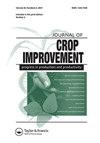Fungal diseases of eggplant (Solanum melongena L.) and components of the disease triangle: A review
IF 1.5
Q3 AGRONOMY
引用次数: 3
Abstract
ABSTRACT Eggplant (Solanum melongena L.) is one of the most popular solanaceous vegetable crops cultivated mainly in the tropical and subtropical parts of the world. Eggplant production is challenged by a wide range of pathogens, such as bacteria, fungi, viruses, and nematodes. The fungi cause the most severe economic loss to eggplant farmers due to their widespread incidence and devastating impact on crop yield. The fungal diseases are influenced by several factors, including environmental conditions, physiological and genetic characteristics of the host. Despite the economic implications of fungal diseases in eggplant, a compilation of the current understanding of pathogenesis, disease development and the host-resistance mechanisms remain unavailable. In this article, we comprehensively review common fungal pathogens of eggplant reported worldwide, and the diseases caused by them, including their major symptoms. We also discuss the major environmental factors that favor pathogenesis and summarize the molecular mechanisms underlying the host-pathogen interactions and disease development. Finally, we briefly discuss the prospects for future research to develop modern breeding and agronomic tools for combating the diseases in this important crop.茄子真菌病害及其“病三角”成分研究进展
茄子(Solanum melongena L.)是世界上主要种植在热带和亚热带地区的最受欢迎的茄科蔬菜作物之一。茄子生产受到各种病原体的挑战,如细菌、真菌、病毒和线虫。真菌由于其广泛的发病率和对作物产量的破坏性影响,给茄子种植户造成了最严重的经济损失。真菌疾病受到多种因素的影响,包括环境条件、宿主的生理和遗传特征。尽管茄子真菌疾病具有经济意义,但目前对发病机制、疾病发展和寄主抗性机制的了解还没有汇编。本文全面综述了世界各地报道的茄子常见真菌病原体及其引起的疾病,包括主要症状。我们还讨论了有利于发病的主要环境因素,并总结了宿主-病原体相互作用和疾病发展的分子机制。最后,我们简要讨论了未来研究的前景,以开发现代育种和农艺工具来对抗这种重要作物的疾病。
本文章由计算机程序翻译,如有差异,请以英文原文为准。
求助全文
约1分钟内获得全文
求助全文
来源期刊

Journal of Crop Improvement
Multiple-
CiteScore
3.30
自引率
7.70%
发文量
42
期刊介绍:
Journal of Crop Science and Biotechnology (JCSB) is a peer-reviewed international journal published four times a year. JCSB publishes novel and advanced original research articles on topics related to the production science of field crops and resource plants, including cropping systems, sustainable agriculture, environmental change, post-harvest management, biodiversity, crop improvement, and recent advances in physiology and molecular biology. Also covered are related subjects in a wide range of sciences such as the ecological and physiological aspects of crop production and genetic, breeding, and biotechnological approaches for crop improvement.
 求助内容:
求助内容: 应助结果提醒方式:
应助结果提醒方式:


